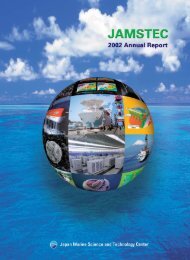2007 Annual Report - jamstec japan agency for marine-earth ...
2007 Annual Report - jamstec japan agency for marine-earth ...
2007 Annual Report - jamstec japan agency for marine-earth ...
You also want an ePaper? Increase the reach of your titles
YUMPU automatically turns print PDFs into web optimized ePapers that Google loves.
along the Gulf Stream, and in July and August along the<br />
Kuroshio/Oyashio. An important point to note is that major<br />
variations in the Gulf Stream or Kuroshio/Oyashio do not necessarily<br />
generate significant atmospheric anomalies, since their<br />
impact on the near-surface baroclinicity may be canceled by the<br />
land surface temperature anomalies or dwarfed by baroclinic<br />
anomalies associated with the land surface temperature anomalies.<br />
Their impact on the near-surface baroclinicity may be<br />
ignored by the large-scale atmospheric motions when the jet<br />
flows away from the area of baroclinic anomalies also. These<br />
factors make it difficult to detect the impact of extratropical<br />
SST anomalies on the large-scale atmospheric state when the<br />
data are analyzed with the SST in focus. We will be extending<br />
this research by examining the atmospheric response to SST<br />
anomalies in the vicinity of the Kuroshio/Oyashio in the summer,<br />
using a regional atmospheric simulation model at a very<br />
high spatial resolution required to resolve narrow bands of SST<br />
anomalies along the oceanic fronts.<br />
Interannual variability of the East Asian winter monsoon<br />
exerts significant influence on weather conditions over Japan,<br />
including severe cold waves in the 2005/6 winter and anomalous<br />
mildness in the 2004/5 winter. We have been investigating<br />
the causes and predictability of the monsoon variability,<br />
focusing on the remote influence of the tropical variability and<br />
anomalous sea ice cover in the Arctic. It is suggested though<br />
our experiments with an atmospheric general circulation model<br />
anomalous Aleutian Low requires our deeper understanding of<br />
the ocean-to-atmosphere feedback in the subpolar oceanic<br />
frontal zone. We have found through our analysis of an eddyresolving<br />
OFES hindcast integration that cool SST anomalies<br />
that <strong>for</strong>m off the Hokkaido Island along the strengthened<br />
Oyashio tend to extend eastward along the subpolar front in<br />
cooling the overlying atmosphere. This tendency indicates that<br />
SST anomalies generated through such oceanic processes as<br />
advective effect of the Oyashio and equatorward displacement<br />
of the subpolar front can exert thermal <strong>for</strong>cing on the atmosphere.<br />
In order to further explore the characteristic nature of airsea<br />
interaction in a midlatitude oceanic frontal zone, we analyze<br />
an output of a high-resolution CGCM CFES on the Earth<br />
Simulator. With its eddy-permitting ocean component, CFES<br />
can represent a well-defined oceanic front on the warmer flank<br />
of the strong Antarctic Circumpolar Current. Tight surface air<br />
temperature SAT gradient that is maintained across the<br />
prominent SST front energizes individual cyclones and anticyclones<br />
to anchor the core of the Southern Hemisphere storm<br />
track where the surface westerlies are particularly strong due to<br />
poleward eddy heat transport. Our analysis reveals Fig.5<br />
that on the warmer side of the SST front a huge amount of heat<br />
is released from the ocean into cold air behind a cold front<br />
while on the cooler side of the SST front the ocean cools off<br />
warm air behind a warm front. After relaxed by poleward heat<br />
transport by atmospheric disturbances, SAT gradient across the<br />
AFES on the Earth Simulator that below-normal sea ice<br />
cover within the Barents/Kara Seas in late autumn may possibly<br />
lead to above-normal intensity of the wintertime Siberian High.<br />
Furthermore, we have identified a stationary tropospheric wave<br />
train in late winter over the Eurasian continent as a precursory<br />
signal of a midwinter surface pressure anomaly similar to the<br />
Arctic Oscillation AO. The wave train modifies the upward<br />
propagation of the climatological planetary waves, leading to<br />
the <strong>for</strong>mation of an AO-like anomaly in the stratosphere and its<br />
subsequent extension down to the surface. These are significant<br />
findings that can be key factors <strong>for</strong> seasonal <strong>for</strong>ecast of wintertime<br />
weather over the Far East.<br />
Deeper understanding of the decadal climate variability<br />
inherent to the midlatitude North Pacific that accompanies the<br />
Fig.5 Air-sea interaction characteristic of the oceanic frontal zone<br />
in the South Indian Ocean reproduced in a high-resolution coupled<br />
ocean-atmosphere GCM CFES. Latitude-time section <strong>for</strong> 55˚E from<br />
July to September of the first year. upper Surface air temperature<br />
SAT; contoured <strong>for</strong> every 2 degs. and SST-SAT colored as indicated<br />
on the right; bright colors <strong>for</strong> positive values. lower SST contoured<br />
<strong>for</strong> every 2 degs. and sensible heat flux from the ocean surface<br />
colored as indicated on the right; bright colors <strong>for</strong> upward flux
















